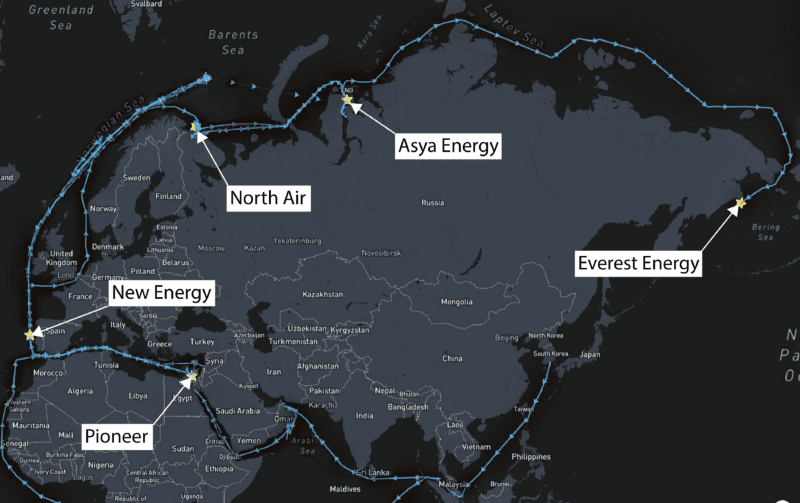Unions Slam Trump For Giving China A Pass On Shipbuilding
By Joe Deaux and Laura Curtis Nov 8, 2025 (Bloomberg) –A group of labor unions led by the United Steelworkers slammed the Trump administration for suspending port fees on Chinese ships...
By Malte Humpert (gCaptain) –
Russia’s nascent LNG shadow fleet remains in a state of disarray with no completed deliveries more than six weeks after LNGC Pioneer lifted the first cargo in early August. Over the weekend LNGC Asya Energy called at the Arctic LNG 2 project for a second time loading the fifth batch of super-chilled gas.
U.S. sanctions and the suspension of ship registrations by Palau appear effective at slowing down Arctic LNG 2’s export plans. The first four loadings remain in limbo with the destination of the fifth one likewise yet to be determined.
The initial cargo lifted by LNGC Pioneer more than six weeks ago and transferred to New Energy near the Suez Canal now appears set to return to the Russian Arctic completing a six-week odyssey across the North Sea, Eastern Atlantic, and the Mediterranean.
Following the ship-to-ship transfer at the end of August, both Pioneer and New Energy stayed put near the northern terminus of the Suez Canal for more than two weeks, where the former still remains. New Energy meanwhile began its slow journey back through Gibraltar and turned in a northerly direction, likely heading back to the waters near Murmansk, possibly to discharge its cargo into the Saam FSU storage barge.
By the time it can complete any offloading nearly two months will have passed, resulting in a boil-off loss of between 10-15 percent. Older steam turbine carriers face losses between 0.15-0.25 percent of cargo per day.
The fate of the second and third cargoes lifted from Arctic LNG 2 remain similarly in limbo. Asya Energy departed from the project around August 10 and made its way partially down Norway’s coastline before returning to Kola Bay where it idled for a week near Murmansk.
During this time Everest Energy lifted the third cargo from the plant and discharged it into Saam FSU around a week later. Several days later Asya Energy followed suit, traveling from nearby Kola Bay. Both cargos remain in the FSU awaiting eventual pickup. One candidate for onward transport may be North Air, a sanctioned newbuild ice-class LNG carrier holding position in the vicinity.
Following discharging their cargo at Saam FSU both Everest Energy and Asya Energy returned to Arctic LNG 2 to pick up the fourth and fifth cargo, respectively.
The former transited the Northern Sea Route in an easterly direction and passed through the Bering Strait over the weekend. Its destination, almost certainly in Asia, remains unknown. It may discharge its cargo in a second floating storage barge, Koryak FSU, positioned by Novatek at the southern tip of Kamchatka in the summer of 2023.

Asya Energy may follow in its tracks or could possibly complete another drop-off at Saam FSU, though this would presuppose a pick-up by North Air or another vessel as the floating storage barge is near capacity after receiving two deliveries.
Discharging cargo into Saam FSU has bought Arctic LNG 2’s management some time to arrange for onward transport. Similarly, train 1 of Arctic LNG 2 comes with 230,000 cubic meters of LNG storage, around 10 days worth of production at current rates.
However, the fact that five batches of LNG remain undelivered is a sign of the challenges the project faces.
The inability to complete deliveries binds the project’s limited shipping capacity at a time when Arctic LNG 2 is looking to establish a dependable operation.
These logistical challenges stand to increase in the months to come as sea ice returns to the region limiting the use of the currently deployed conventional carriers. Ice-capable vessels ordered for the project remain stuck at South Korea’s Hanwha shipyard.

Sign up for gCaptain’s newsletter and never miss an update

Subscribe to gCaptain Daily and stay informed with the latest global maritime and offshore news
Essential news coupled with the finest maritime content sourced from across the globe.
Sign Up